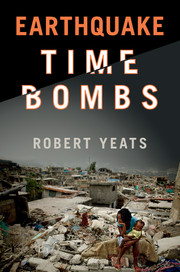Book contents
- Frontmatter
- Contents
- Acknowledgments
- Why this book?
- PART I EARTHQUAKES, DEEP TIME, AND THE POPULATION EXPLOSION
- PART II EARTHQUAKE TIME BOMBS
- TIME BOMBS WHERE THE PROBLEM IS UNDERSTOOD, BUT THE RESPONSE IS STILL INADEQUATE
- OTHER TIME BOMBS, INCLUDING CITIES THAT ARE NOT WELL PREPARED
- 13 Age of Enlightenment and the 1755 Lisbon earthquake
- 14 Jerusalem: earthquakes in the Holy Land
- 15 Istanbul: responding to an official earthquake warning
- 16 Tehran: the next earthquake in the Islamic Republic of Iran?
- 17 Kabul: decades of war and Babur's warning
- 18 Earthquakes in the Himalaya
- 19 Myanmar and the Sagaing fault
- 20 Metro Manila, the Philippines
- 21 Lima, Peru: Inca earthquake-resistant construction and a bogus American earthquake prediction
- 22 Andean earthquakes in Quito and Guayaquil, Ecuador
- 23 Caracas: lots of oil, but little interest in earthquakes
- 24 Haiti, which lost its gamble, and Jamaica and Cuba (not yet)
- 25 Mexico City: bowl of jello inherited from the Aztecs
- 26 Central America and the earthquake that brought down a dictator
- 27 East African Rift Valley: a tale of two cities
- PART III SUMMARY AND RECOMMENDATIONS
- References
- Index
19 - Myanmar and the Sagaing fault
from OTHER TIME BOMBS, INCLUDING CITIES THAT ARE NOT WELL PREPARED
Published online by Cambridge University Press: 05 November 2015
- Frontmatter
- Contents
- Acknowledgments
- Why this book?
- PART I EARTHQUAKES, DEEP TIME, AND THE POPULATION EXPLOSION
- PART II EARTHQUAKE TIME BOMBS
- TIME BOMBS WHERE THE PROBLEM IS UNDERSTOOD, BUT THE RESPONSE IS STILL INADEQUATE
- OTHER TIME BOMBS, INCLUDING CITIES THAT ARE NOT WELL PREPARED
- 13 Age of Enlightenment and the 1755 Lisbon earthquake
- 14 Jerusalem: earthquakes in the Holy Land
- 15 Istanbul: responding to an official earthquake warning
- 16 Tehran: the next earthquake in the Islamic Republic of Iran?
- 17 Kabul: decades of war and Babur's warning
- 18 Earthquakes in the Himalaya
- 19 Myanmar and the Sagaing fault
- 20 Metro Manila, the Philippines
- 21 Lima, Peru: Inca earthquake-resistant construction and a bogus American earthquake prediction
- 22 Andean earthquakes in Quito and Guayaquil, Ecuador
- 23 Caracas: lots of oil, but little interest in earthquakes
- 24 Haiti, which lost its gamble, and Jamaica and Cuba (not yet)
- 25 Mexico City: bowl of jello inherited from the Aztecs
- 26 Central America and the earthquake that brought down a dictator
- 27 East African Rift Valley: a tale of two cities
- PART III SUMMARY AND RECOMMENDATIONS
- References
- Index
Summary
Burma, renamed Myanmar by its government in 1989, is one of the world's poorest countries, even though it is rich in natural resources. It has a written history lasting more than 2000 years, and the country has been predominantly Buddhist for most of that time. It was a major rice-exporting country before World War II. The kingdom fell to British rule in the nineteenth century, although the British occupation was marked by riots, rebellion, and demonstrations, including protests by Buddhist monks. A strike in 1936 at Rangoon University led by a student leader named Aung San was put down violently.
In the spring of 1942, the country was overrun by the Imperial Japanese Army, and Allied actions against the Japanese in Burma used the famous Burma Road from southwest China. In 1945, the Japanese were expelled; Aung San was one of the leaders advocating independence from British rule. On July 19, 1947, Aung San was assassinated, and the anniversary of that day is now celebrated as Martyr's Day. Independence was achieved the following January, although Burma elected not to join the British Commonwealth. The early days of independence were marked by attempts at revolution, some led by Communists.
In 1962, the government of Burma was overthrown in a military coup, and a half century later, the military is still in charge. After 1962, separatist movements arose, particularly in the Shan States in the eastern part of the country. Some of these separatist movements are still active, including Muslim riots in the western part of the country close to Bangladesh. After a mass uprising in 1988 supporting democracy, the governing junta permitted elections to be held in May 1990, with the National League for Democracy, led by Aung San's daughter, Aung San Suu Kyi, winner in a landslide victory. However, the military government refused to abide by the results of that election, and Aung San Suu Kyi, winner of the Nobel Peace Prize in 1991, was kept under house arrest until the regime allowed democratic reforms in 2011–2012. She was elected to Parliament in 2012, and the regime appears to be emerging from its isolation and sanctions as a pariah state, although demonstrations against the Muslim minority continue.
- Type
- Chapter
- Information
- Earthquake Time Bombs , pp. 235 - 242Publisher: Cambridge University PressPrint publication year: 2015



